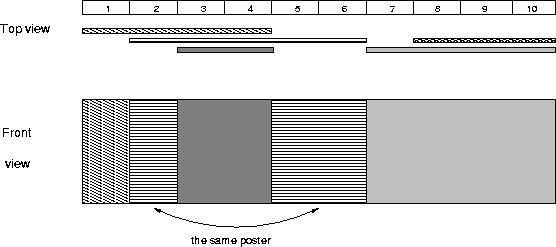Description
The citizens of Bytetown, AB, could not stand that the candidates in the mayoral election campaign have been placing their electoral posters at all places at their whim. The city council has finally decided to build an electoral wall for placing the posters and introduce the following rules:
They have built a wall 10000000 bytes long (such that there is enough place for all candidates). When the electoral campaign was restarted, the candidates were placing their posters on the wall and their posters differed widely in width. Moreover, the candidates started placing their posters on wall segments already occupied by other posters. Everyone in Bytetown was curious whose posters will be visible (entirely or in part) on the last day before elections.
Your task is to find the number of visible posters when all the posters are placed given the information about posters' size, their place and order of placement on the electoral wall.
- Every candidate can place exactly one poster on the wall.
- All posters are of the same height equal to the height of the wall; the width of a poster can be any integer number of bytes (byte is the unit of length in Bytetown).
- The wall is divided into segments and the width of each segment is one byte.
- Each poster must completely cover a contiguous number of wall segments.
They have built a wall 10000000 bytes long (such that there is enough place for all candidates). When the electoral campaign was restarted, the candidates were placing their posters on the wall and their posters differed widely in width. Moreover, the candidates started placing their posters on wall segments already occupied by other posters. Everyone in Bytetown was curious whose posters will be visible (entirely or in part) on the last day before elections.
Your task is to find the number of visible posters when all the posters are placed given the information about posters' size, their place and order of placement on the electoral wall.
Input
The first line of input contains a number c giving the number of cases that follow. The first line of data for a single case contains number 1 <= n <= 10000. The subsequent n lines describe the posters in the order in which they were placed. The i-th line among the n lines contains two integer numbers l
i and ri which are the number of the wall segment occupied by the left end and the right end of the i-th poster, respectively. We know that for each 1 <= i <= n, 1 <= l
i <= ri <= 10000000. After the i-th poster is placed, it entirely covers all wall segments numbered l
i, l
i+1 ,... , ri.
Output
For each input data set print the number of visible posters after all the posters are placed.
The picture below illustrates the case of the sample input.

The picture below illustrates the case of the sample input.

Sample Input
1 5 1 4 2 6 8 10 3 4 7 10
Sample Output
4
解题思路
因为广告墙很长,建线段树建不了,所以要用到离散化,离散化分三种情况,原来重合的点还是重合,原来相邻的点还是相邻,原来相离的点现在相隔距离变为一,这是为了
防止原来后面的颜色会露出,而现在会完全挡住。刚看到时一直不理解。。。
AC代码
#include<cstdio>
#include<cstring>
#include<iostream>
#include<algorithm>
using namespace std;
#define lson l,m,rt<<1
#define rson m+1,r,rt<<1|1
int col[1 << 17];
int ans;
typedef struct S
{
int pos, id;
} NODE;
NODE node[20010];
bool cmp(NODE a, NODE b)
{
return a.pos < b.pos;
}
int ls[20010];
int vis[40010];
void pushdown(int rt, int len)
{
if (col[rt] != -1)
{
col[rt << 1] = col[rt << 1 | 1] = col[rt];
col[rt] = -1;
}
}
void update(int L, int R, int c, int l, int r, int rt)
{
if (L <= l && R >= r)
{
col[rt] = c;
return;
}
pushdown(rt, r - l + 1);
int m = (l + r) >> 1;
if (L <= m)
update(L, R, c, lson);
if (R > m)
update(L, R, c, rson);
}
void query(int l, int r, int rt)
{
if(col[rt] != -1)
{
if(!vis[col[rt]])
{
vis[ col[rt] ] = 1;
++ans;
}
return;
}
if(l == r)
return;
int m = (l + r) >> 1;
query(lson);
query(rson);
}
int main()
{
int T, i, j, n, max;
scanf("%d", &T);
while (T--)
{
scanf("%d", &n);
memset(col, -1, sizeof (col));
memset(vis,0,sizeof(vis));
for (i = 0; i < n; ++i)
{
node[i << 1].id = i << 1;
scanf("%d", &node[i << 1].pos);
node[i << 1 | 1].id = i << 1 | 1;
scanf("%d", &node[i << 1 | 1].pos);
}
sort(node, node + n + n, cmp);
ls[node[0].id] = 0;
for (i = 1; i < n + n; ++i)
{
if(node[i].pos == node[i - 1].pos)
ls[node[i].id] = ls[node[i - 1].id];
else if(node[i].pos == node[i - 1].pos + 1)
ls[node[i].id] = ls[node[i - 1].id] + 1;
else
ls[node[i].id] = ls[node[i - 1].id] + 2;
}
max = ls[node[n + n - 1].id];
for (i = 0; i < n; ++i)
update(ls[i << 1], ls[i << 1 | 1], i, 0, max, 1);
ans = 0;
query(0, max, 1);
printf("%d\n", ans);
}
return 0;
}






















 431
431

 被折叠的 条评论
为什么被折叠?
被折叠的 条评论
为什么被折叠?








